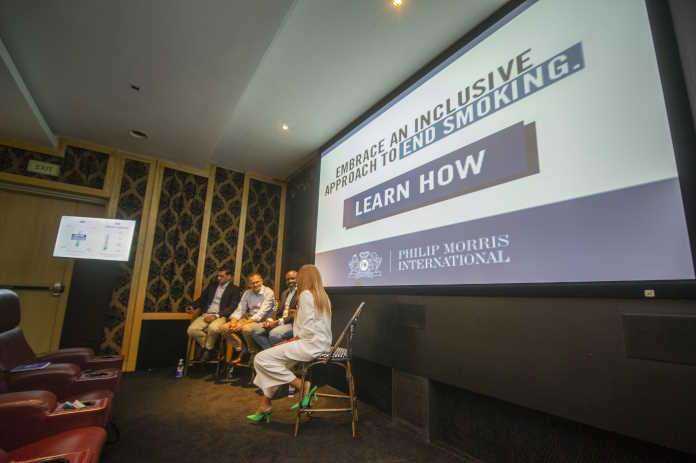More needs to be done to reduce smoking rates in South Africa, says Philip Morris
The growth of heated tobacco products (HTPs) is increasing exponentially and in some markets driving cigarette sales down to historic lows. This as men and women across the globe, who would otherwise continue smoking look to replace cigarettes with less harmful alternatives, says Philip Morris South Africa (PMSA).
The experience and data presented today at a documentary screening event, demonstrated how smoke-free products can play a significant role in tobacco harm reduction and public health. This as public hearings on the proposed Tobacco Products and Electronic Delivery Systems Control Bill are underway across the country.
“Innovation has paved the way to harm reduction for millions of adult smokers worldwide,” said Branislav Bibic, Managing Director at Philip Morris South Africa. In 2000, 50 percent of all men and 33 percent of all adults in Japan smoked cigarettes. Ten years later, Japan’s decline in cigarette sales was still lagging far behind comparable countries.”

In 2015, something changed, sales of cigarettes started declining five times faster, he said the answer began with science. “It would be ideal for the world’s one billion smokers to quit altogether, but the indicators so far show that they will not, therefore the most pragmatic approach would be to use products that eliminate combustion such as e-cigarettes and heated tobacco products.”
This documentary detailed an in-depth look at the impact of IQOS’ introduction in Japan. It looked at Japanese culture, how heated tobacco impacted cigarette sales, and showcased post-market studies featuring key members of the Philip Morris International team, consumers, and third-party spokespeople.
Several studies, including research for the American Cancer Society, suggest the significant decline can be attributed to the uptake of heated tobacco products.
“Japan is a tangible and powerful example of how access to smoke-free alternatives can drastically reduce cigarette sales,” said Bibic. “Two recent independent studies show that cigarette sales in Japan decreased at an accelerated pace after several manufacturers introduced heated tobacco products, including Philip Morris International, to the market.”
According to the latest industry report from the Tobacco Institute of Japan, cigarette consumption decreased by 44 percent in 5 years after the introduction of cigarette alternatives – the highest decline that Japan has ever had.
Bibic said: “According to the harm reduction equation, the more adult smokers who choose the lower risk options instead of continuing to smoke cigarettes, the bigger the impact on reducing population harm.”
“This documentary details how Japan saw an annual average decline of 9.5 percent in cigarette sales from 2015 to 2018 with the introduction of heated tobacco products,” he added. “Reducing tobacco related harm depends not only on the reduction in risk to the individual who switches from cigarettes to smoke-free alternatives but also its adoption by adult smokers.”
Of course, he said, you must consider disposable income, users’ preference, and the regulatory environment to address the need for the right product for the country at the right time, but the Japanese experience can certainly be replicated in other countries like South Africa.
He continued to explain that other countries are adopting successful harm reduction approaches or embracing it. Public Health England has stated that “Alternative nicotine delivery devices, such as nicotine vaping products, could play a crucial role in reducing the enormous health burden caused by cigarette smoking.” And the U.S. FDA has established the Modified Risk Tobacco Products pathway which allows companies a way to gain authorisation to provide important information about their smoke-free products.
“Sweden is another example, which came before the harm reduction story in Japan,” he added. “It has been reported that the use of snus played an important role in decreasing smoking prevalence in the country, especially among men, and a lower rate of lung cancer and heart attacks among men in the country was observed.”
All this evidence he stated demonstrates that when you must have the right product to help smokers who won’t quit to switch, you will experience the decline in cigarette sales and impact on public health, smoke-free alternatives can play a key role in harm reduction.
While the focus of the documentary is on Japan, Bibic noted that these findings suggest that scientifically substantiated smoke-free alternatives, such as IQOS, have a role to play in providing smokers who don’t quit with less harmful alternatives than cigarettes.
“There is a real opportunity in South Africa to look at how this decline was achieved, and the regulations implemented by the Japanese government to make this possible in the interest of public health,” he said.
Most notably he added that, the introduction of HTPs has not caused an increase in overall sales of tobacco products, and the availability of HTPs has had a low impact on the initiation of tobacco use by never-smokers and re-initiation by former smokers.
“Heated tobacco products are less harmful than smoking cigarettes because they heat tobacco instead of burning it. “Burning tobacco releases the vast majority of harmful chemicals which experts agree are the main cause of smoking-related diseases,” he added. “IQOS by way of example produces 95 percent lower levels of harmful chemicals compared to the smoke of a reference cigarette.”
While he cautioned that IQOS is not risk-free, and it doesn’t necessarily equate to a 95 percent reduction in risk as it contains nicotine which is addictive and not risk-free. He added that it is not the primary cause of smoking-related diseases.
“There are 12 million adult smokers in South Africa, almost one-fifth of the population, most of whom will continue to smoke cigarettes,” he added. “Regulations that enable adult smokers to understand why these products are different from cigarettes, and that encourage those who would otherwise continue smoking to change to less harmful alternatives are needed in South Africa to accelerate the decline of smoking.”
“Addressing misinformation with facts and science is a collective responsibility to achieve a smoke-free future faster, while misinformation is a persisting threat with real-world consequences for people who smoke in this country,” he said. “Regulation and support for alternatives to smoking has shown to be successful and regulators need only to look at the data and science to see the impact.”
“Persistent misinformation is causing confusion and holding back adult smokers who do not quit from making more informed choices than continued smoking,” he explained. “It’s clear that accurate information about smoke-free products plays a critical role to help adults who would otherwise continue smoking, to change to less harmful alternatives.”
He added that by providing consumers with science-based information about better alternatives, we can accelerate the decline in smoking rates, helping to end the use of cigarettes once and for all.
“With the right regulatory encouragement, support from civil society, and the full embrace of science, a smoke-free future is possible in South Africa sooner rather than later, with cigarette sales becoming a thing of the past,” he said. “The draft Control of Tobacco Products and Electronic Delivery Systems Bill provides the country with an opportunity to make this a possibility by differentiating the way in which scientifically substantiated products that don’t burn tobacco are regulated compared to cigarettes.”
He concluded by stating that the company is looking forward to the future as harm reduction gains more recognition globally. “PMI is the only tobacco company to have publicly staked its future on replacing cigarettes with scientifically substantiated better alternatives,” he said. “That vision seems ever more possible and even likely—as new trends and technology become available to reduce harm among tobacco users.”












